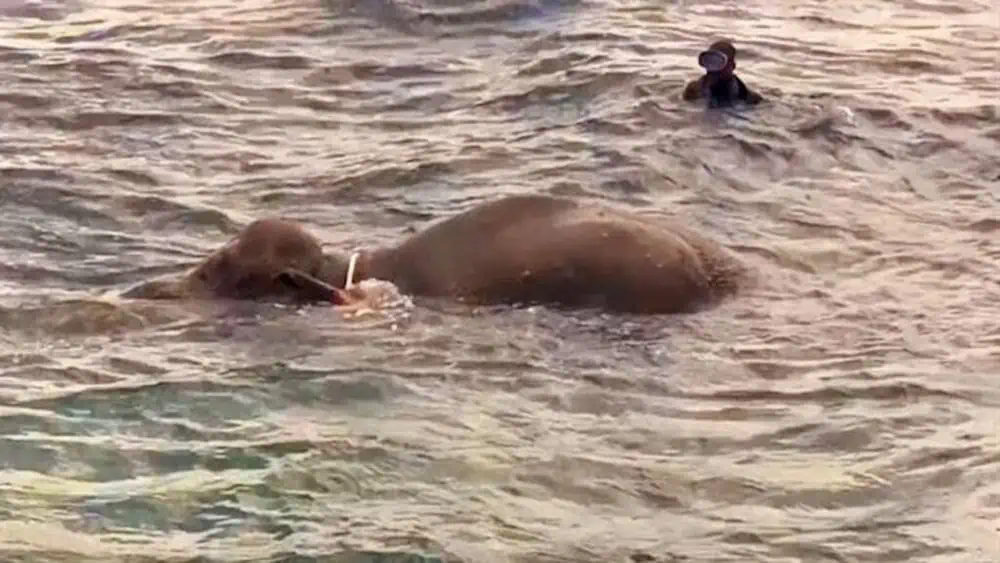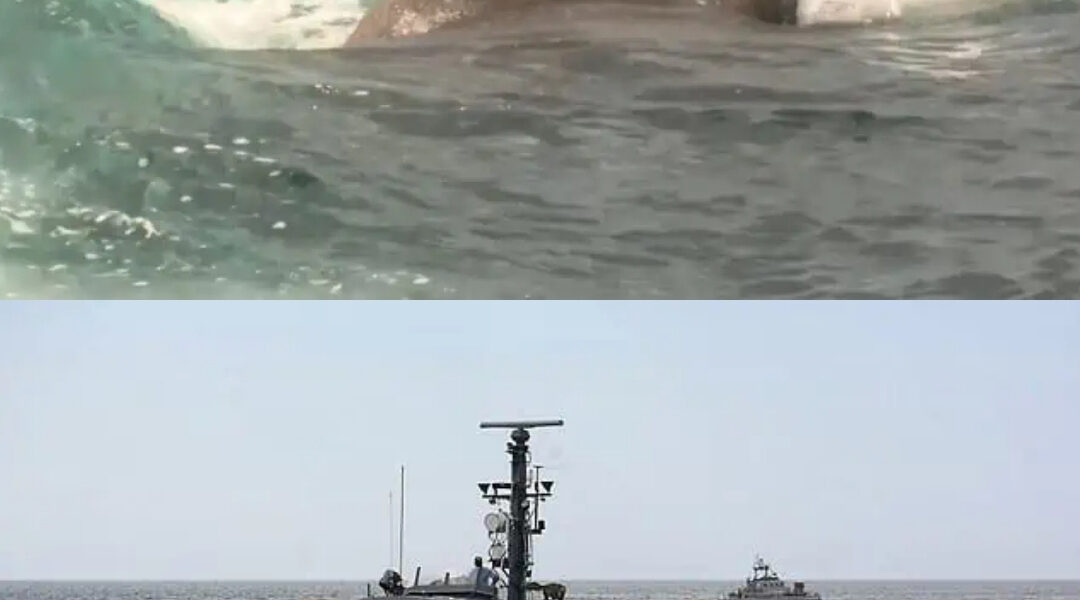The morning began like any other along Sri Lanka’s northeastern coast — calm seas, sunlight flickering across the waves, and fishermen setting out for their daily work. But not far beyond the shore, something unusual broke the rhythm of the ocean: a faint, rhythmic movement cutting through the vast blue expanse. At first, the sailors aboard a navy patrol vessel thought it might be debris or driftwood. Then they saw it — a long, grey trunk rising above the water, curling, and sinking again.

It was an elephant.
Five miles from land, the massive animal was struggling to stay afloat, its head dipping beneath the surface before pushing up again in desperate gasps. Its trunk — the only part clearly visible — served as a snorkel, sucking in air as the rest of its body battled exhaustion and current.
The sight stunned the crew. Elephants were known to wade through shallow lagoons and rivers, even swim short distances when needed. But this one had drifted far beyond safety — into open sea. Somehow, it had been swept away while trying to cross the Kokkilai lagoon, where strong currents often flow between two forested areas. Alone in the vast ocean, it had been fighting for hours, maybe longer.

The navy immediately radioed for help. Within minutes, a rescue team was mobilized — divers, wildlife officials, and boats equipped with ropes and harnesses. The operation would soon become one of the most extraordinary animal rescues the country had ever seen.
As the boats drew closer, the rescuers could see the elephant’s eyes — wide with fear, ringed with exhaustion. Its movements were slowing, each attempt to keep its head above water weaker than the last. “It was heartbreaking,” said one diver later. “You could see it was losing strength, but it was still trying.”
Approaching the animal was risky. Even in distress, an elephant is powerful enough to overturn a small vessel with one misplaced swing of its trunk. The divers knew they had to move with care — calm voices, no sudden splashes. The sea was choppy, and the elephant’s massive body rose and sank like a living island.

They began by circling it slowly, gauging its movements. Then, in pairs, the divers slipped into the water, ropes coiled around their shoulders. One by one, they swam toward the elephant, speaking softly, extending hands as if to reassure it. “It was almost like talking to a frightened child,” one rescuer said. “We wanted it to know we were there to help.”
After several tense attempts, they managed to loop ropes around the elephant’s midsection and chest. From nearby boats, others began to pull gently, adjusting their pace so as not to panic the animal. It was a delicate balance — too fast, and the ropes might injure it; too slow, and it might tire out completely.
Hour after hour, the team worked under the punishing sun. The salt stung their eyes; the sea swayed with every gust of wind. But they didn’t stop. Every few minutes, the elephant let out a low, rumbling sound — half cry, half groan — as if asking for strength.

By late afternoon, they had managed to tow the elephant closer to shore. The water grew shallower, turning from deep indigo to green, and then to brown. The animal’s feet brushed sand for the first time in hours. The rescuers cheered — but carefully, softly, as if afraid the sound might break the fragile calm.
Finally, as twilight painted the horizon gold, the elephant took a staggering step forward — then another. Supported by the ropes, it lumbered slowly toward the beach, collapsing briefly in the shallows before standing again. The crowd that had gathered onshore — villagers, soldiers, and children — erupted in tears and applause.
Twelve hours after the rescue began, the elephant was free.
It stood there for a long while, facing the sea as waves lapped at its legs. Its chest rose and fell heavily, but its trunk lifted once more — high, proud, as if in salute to those who had saved it. Then, with a final rumble that rolled through the evening air, it turned and disappeared into the forest.
For the rescuers, exhaustion was replaced by quiet wonder. “It’s hard to describe,” said Navy spokesperson Chaminda Walakuluge. “You feel small next to something like that — the strength it took for that animal to survive, and the compassion it took to bring it home.”

The rescue became a national story — not just because of its scale, but because of what it represented. In a world often defined by human destruction, this was the opposite: humans and nature, side by side, fighting for the same heartbeat.
It wasn’t the first time Sri Lanka’s navy had performed such a feat. Only weeks earlier, they had helped save 20 stranded pilot whales near Trincomalee. But something about this rescue struck deeper — perhaps because elephants, sacred and symbolic, have always been part of Sri Lanka’s soul.
Wildlife experts later explained that elephants can swim for many miles, sometimes using their trunks as natural snorkels, but exhaustion, strong currents, or disorientation can turn that ability into peril. The Kokkilai lagoon, where this one had begun its journey, often tempts elephants to cross — not realizing how easily the tides can change.
By dawn the next day, the waters were calm again. The ropes had been coiled, the boats docked, and the rescue team had gone home. But along the shoreline, faint impressions of wide, round footprints still marked the sand — a silent testimony to courage, both human and wild.
Some say the elephant returned to its herd deep in the forest. Others like to believe it still remembers — that somewhere, in that vast memory elephants are known for, there’s an image of faces in the water, voices in the wind, and hands reaching through the waves to bring it home.
And perhaps, when it raises its trunk toward the sea at sunset, it’s not just smelling the air — it’s saying thank you.




